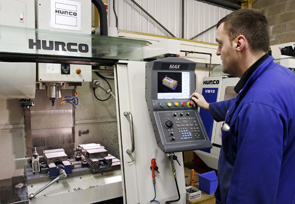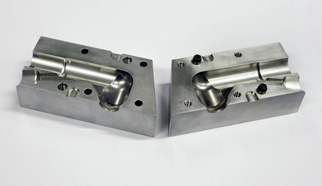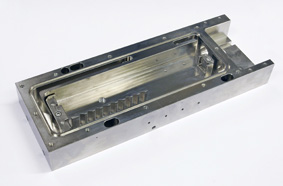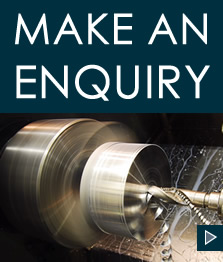Press Articles
RECENT ARTICLE FROM 'ENGINEERING SUBCONTRACTOR' JULY 2012
DIVERSITY SECURES RAPID GROWTH FOR SCOTTISH SUBCONTRACTOR
 Since its formation in 2005, DW Engineering has expanded its Hamilton, South Lanarkshire contract machining business at an impressive rate. Its success is largely down to an ability and willingness to undertake anything from prototype work to large batch production for many different industries, and to offer machining expertise in a wide range of materials.
Since its formation in 2005, DW Engineering has expanded its Hamilton, South Lanarkshire contract machining business at an impressive rate. Its success is largely down to an ability and willingness to undertake anything from prototype work to large batch production for many different industries, and to offer machining expertise in a wide range of materials.
VM1 and VM10 machining centres at DW Engineering
A further reason for the company's rapid progress, according to owner, David Watt, is the exclusive use of Hurco vertical machining centres (VMCs) for prismatic metalcutting.
He said, "They allow fast, accurate shop floor programming as well as easy import of externally prepared data. "The machines have been central to our ability to offer top quality work, quick turnaround and attractive prices. "As a result, we gain most new business through recommendations from existing customers."Main sectors serviced are gas sensing, medical, aerospace (2nd tier supply) and oil/gas, for which injection moulds are machined for producing plastic components. The variety of materials machined is vast. Metals include stainless and mild steels, titanium, copper, bronze, brass and aluminium.
 In addition, a broad spectrum of plastics is cut, including PTFE, PEEK, Delrin, all grades of nylon and glass filled laminates. Considerable knowledge has been accrued in workholding, tooling and machining strategies for the often delicate materials.
In addition, a broad spectrum of plastics is cut, including PTFE, PEEK, Delrin, all grades of nylon and glass filled laminates. Considerable knowledge has been accrued in workholding, tooling and machining strategies for the often delicate materials.
Accuracies routinely achieved are ± 0.1 mm but some gas sensing and aerospace parts have drawing tolerances down to ± 10 microns, which are easily held. The gas sensing components are used in anything from domestic boilers to laser-based drug testing equipment and airport scanners for explosives.
Two halves of an aluminium injection mould machined on the VM10
Some contracts are exacting. A recent job won back from the Far East, due to poor accuracy machining carried out by a Chinese supplier, required an array of 750 aluminium gas sensor parts to be machined from aluminium plate. This particular job was supplied by the customer as a DXF file, which Hurco controls can import directly. Each part has three fine-pitched, M3 x 0.25 mm tapped holes. The milling, drilling and tapping operations are carried out on a Hurco VM10 in a 7-hour cycle, after which the individual components are separated from the plate and transferred in batches to a Hurco VM1 for second and third operations. They involve clamping the parts 12 at a time in two fixtures for skimming and then drilling of a single cross hole in each component.
DW Engineering also machines stainless steel screws and pins for this sensor assembly. Another contract for the same industry entails deep hole drilling two 300 mm long by 6.35 mm diameter holes through an aluminium billet. Each 47xD hole is machined in 12 minutes using a long-series carbide drill from ITC.
 Mr Watt's first experience of Hurco machines was operating a VMC and a knee mill in his father's subcontract business during the early 1990s. Both were equipped with the manufacturer's own Ultimax conversational control system, which is characterised by having two screens. One is used in touch mode for entering data via the drop-down menu buttons, while the other displays a graphic of the part as it is created, allowing most programming errors to be spotted immediately.
Mr Watt's first experience of Hurco machines was operating a VMC and a knee mill in his father's subcontract business during the early 1990s. Both were equipped with the manufacturer's own Ultimax conversational control system, which is characterised by having two screens. One is used in touch mode for entering data via the drop-down menu buttons, while the other displays a graphic of the part as it is created, allowing most programming errors to be spotted immediately.
Aluminium gas sensing block machined on the VM10
It was this early exposure to the user-friendliness and power of the CNC system that encouraged Mr Watts to standardise on Hurco VMCs when he started his own company. First on-site were a BMC2416 VMC with nominal half-metre-cube capacity and two Hawk 5M mills. The VM1 with 4th axis was installed mid 2009, followed by the VM10 a year later.By this time, the control had become even more powerful due to the introduction of considerably expanded functionality and the adoption of the Windows operating system. The so-called WinMax software suite contains a feature called Swept Surface that is particularly useful to DW Engineering. It allows complex mould tool machining cycles with advanced cutting strategies to be generated in one conversational data block by sweeping a 2D surface over a contour.
"It is unbelievably quick," confirmed Mr Watt, "and the continuous toolpath generates a very smooth surface finish."
The facility is ideal for DW Engineering, as lately mouldmaking has increased to account for some 15 per cent of turnover, principally for a company in Aberdeen that supplies cable joints used on subsea control pods and camera mounts. Each half of the aluminium injection mould spends two to three hours on one of the Hurcos, as very small step-overs are used when programming the ball nose milling cutters to perform the finishing passes. The end user's name and logo are sometimes engraved into the mould surface during the cycle using WinMax Lettering software.
The quality of the moulds directly off the Hurcos is excellent, according to Mr Watt, who said that the mirror finish requires hardly any polishing. Each mould produces around 5,000-off plastic joints. Programming is invariably done on the shop floor in WinMax due to its simplicity, although the subcontractor operates seats of AutoCAD and SolidWorks to handle customer files supplied in those native languages or in the IGES and STEP neutral data formats.

